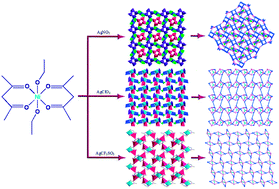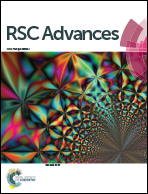Syntheses, structures, and luminescence properties of anion-controlled heterometal modular coordination polymers based on a metalloligand†
Abstract
Three new heterometallic coordination polymers (CPs) formulated as [NiAg3(acac)3(NO3)2(H2O)]n (2), [NiAg3(acac)3(ClO4)2(EtOH)2]n (3), and [NiAg2(acac)2(CF3SO3)2(H2O)2]n (4) have been obtained following a synthetic strategy of introducing AgX (X = NO3−, ClO4−, CF3SO3−) to react with a metalloligand [Ni(acac)2(EtOH)2]n (1, Hacac = acetylacetone). Their structures have been determined by single-crystal X-ray diffraction analyses and compounds 2–4 are further characterized by elemental analyses, IR spectra, powder X-ray diffraction (PXRD) and thermogravimetric (TG) analyses. Complex 2 displays an unprecedented three-dimensional (3D) inorganic chiral framework with novel 5-nodal (3,3,4,4,4)-connected (4.82.103)2(42.6)(42.8.103)(43)(44.62)2 topology. Complex 3 possesses 2D inorganic layers holding 7-nodal (3,3,3,3,4,4,4,4)-connected (4.102)2(42.103.12)(42.6)(43)(44.62)2 networks. Complex 4 shows a 2D (4,5)-connected 4,5-L30 layered architecture with (33.4.62.74)(33.42.5) topology. The anions in compounds 2–4 are crucial factors for the formation of the different structures. In addition, the photoluminescent properties of compounds 2–4 are investigated in the solid state at room temperature.

- This article is part of the themed collection: Luminescence and photophysical properties of metal complexes

 Please wait while we load your content...
Please wait while we load your content...